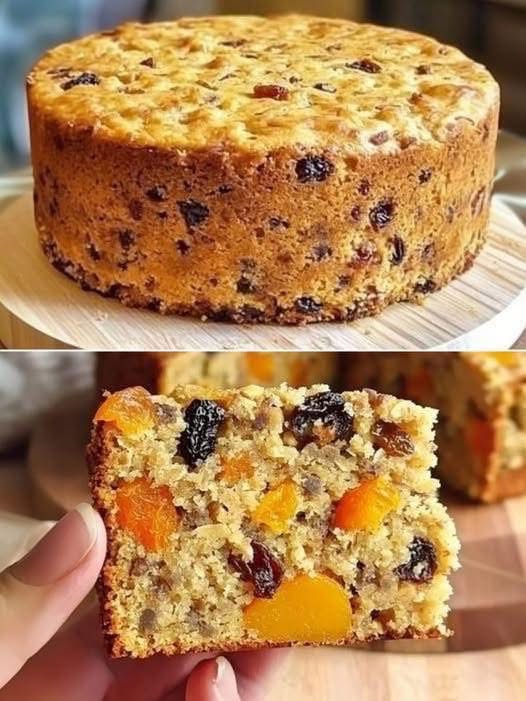Traditional Rich Fruitcake
Introduction
Traditional Rich Fruitcake is the king of holiday bakes — a luxurious, dense, and aromatic cake brimming with dried fruits, nuts, spices, and a hint of brandy or rum. This classic confection has been baked, wrapped, and gifted for centuries, particularly around Christmas and weddings. It’s the kind of cake that gets better with age, as the flavors mature and meld together.
Unlike lighter sponge cakes, a rich fruitcake is meant to be savored slowly — a thin slice with a cup of tea, coffee, or even a little glass of sherry. This recipe follows the old-fashioned method, requiring patience, quality ingredients, and a bit of love.
Ingredients (Serves 12–16)
Dried Fruits:
- 2 cups raisins
- 1½ cups sultanas (golden raisins)
- 1 cup currants
- 1 cup chopped dried apricots
- 1 cup chopped pitted dates
- 1 cup mixed candied peel
- 1 cup glace cherries, halved
Nuts:
- 1½ cups chopped walnuts or pecans
- ½ cup chopped almonds
Liquor & Soaking:
- 1 cup dark rum, brandy, or sherry (plus extra for brushing after baking)
Dry Ingredients:
- 2 cups all-purpose flour
- 1 teaspoon baking powder
- 1 teaspoon ground cinnamon
- 1 teaspoon ground nutmeg
- ½ teaspoon ground cloves
- ½ teaspoon ground allspice
- Pinch of salt
Wet Ingredients:
- 1 cup unsalted butter, softened
- 1 cup brown sugar, packed
- 5 large eggs
- Zest of 1 orange and 1 lemon
- ¼ cup orange juice
- ¼ cup molasses or dark treacle
Instructions
- Soak the Fruit:
- Combine all dried fruits and candied peel in a large bowl.
- Pour over the liquor, stir well, cover, and let soak at least 12 hours (or up to 1 week), stirring occasionally.
- Prepare the Oven & Pan:
- Preheat oven to 275°F (135°C).
- Grease and line a deep 9-inch round or 8×8-inch square cake pan with parchment paper, lining both the bottom and sides.
- Mix Dry Ingredients:
- In a bowl, whisk together flour, baking powder, spices, and salt. Set aside.
- Cream Butter & Sugar:
- In a large mixing bowl, beat butter and brown sugar until light and fluffy.
- Add eggs one at a time, beating well after each addition.
- Stir in citrus zest, juice, and molasses.
- Combine the Batter:
- Fold in the soaked fruit mixture (including any remaining liquid).
- Add chopped nuts.
- Gradually fold in dry ingredients until well combined.
- Bake the Cake:
- Spoon batter into the prepared pan, smoothing the top.
- Bake for 2½–3 hours, checking after 2 hours. If the top browns too quickly, cover loosely with foil.
- Cake is done when a skewer inserted into the center comes out mostly clean (a few moist crumbs are fine).
- Cool & Mature the Cake:
- Cool completely in the pan.
- Remove and wrap tightly in parchment, then foil. Store in an airtight container.
- Brush or “feed” with a tablespoon of liquor every 1–2 weeks for at least 4 weeks before serving.
Methods
- Soaking Method: Deepens flavor and keeps fruit plump.
- Low & Slow Baking: Prevents drying and ensures even cooking.
- Feeding Method: Adding liquor during storage develops richness over time.
History
Fruitcakes have ancient origins — the Romans baked them with pomegranate seeds, pine nuts, and raisins mixed into barley mash. In the Middle Ages, spices and dried fruits from the East transformed the recipe into something closer to what we know today. By the Victorian era, fruitcake had become a symbol of luxury, often served at weddings, Christmas, and royal celebrations.
Benefits
- Long Shelf Life: Can last for months if stored and fed properly.
- Rich Nutritional Value: Packed with dried fruits and nuts for natural fiber, vitamins, and minerals.
- Tradition: Makes holidays feel timeless and festive.
- Make-Ahead Friendly: Improves with age, so you can prepare well before the event.
Formation (Serving & Presentation Tips)
- Serve in thin slices with tea, coffee, or dessert wine.
- For Christmas, decorate with marzipan and royal icing.
- For weddings, cover with fondant for an elegant look.
- Garnish with glazed fruits and nuts for a rustic presentation.
Conclusion
Traditional Rich Fruitcake is more than a dessert — it’s an edible heirloom, connecting us to centuries of celebration. Whether you’re making it for a holiday feast, a wedding, or simply as a treat for yourself, this cake rewards patience with incredible flavor and texture.
For the Lovers
- Holiday Lovers: The aroma and flavor are pure Christmas joy.
- Heritage Lovers: A bite of history in every slice.
- Sweet Tooth Lovers: Dense, sweet, and packed with treats in every mouthful.
Methods (Again)
- Patience Method: The longer it matures, the better it tastes.
- Moisture Control: Keep it well-wrapped to retain tenderness.
- Flavor Infusion: Regular feeding keeps it rich and boozy.
Conclusion (Again)
A Traditional Rich Fruitcake is a labor of love, patience, and tradition. With each slice, you’ll taste not just fruit and spice, but the centuries-old story of celebration it carries — a cake to be savored, remembered, and passed down.Fruitcake
